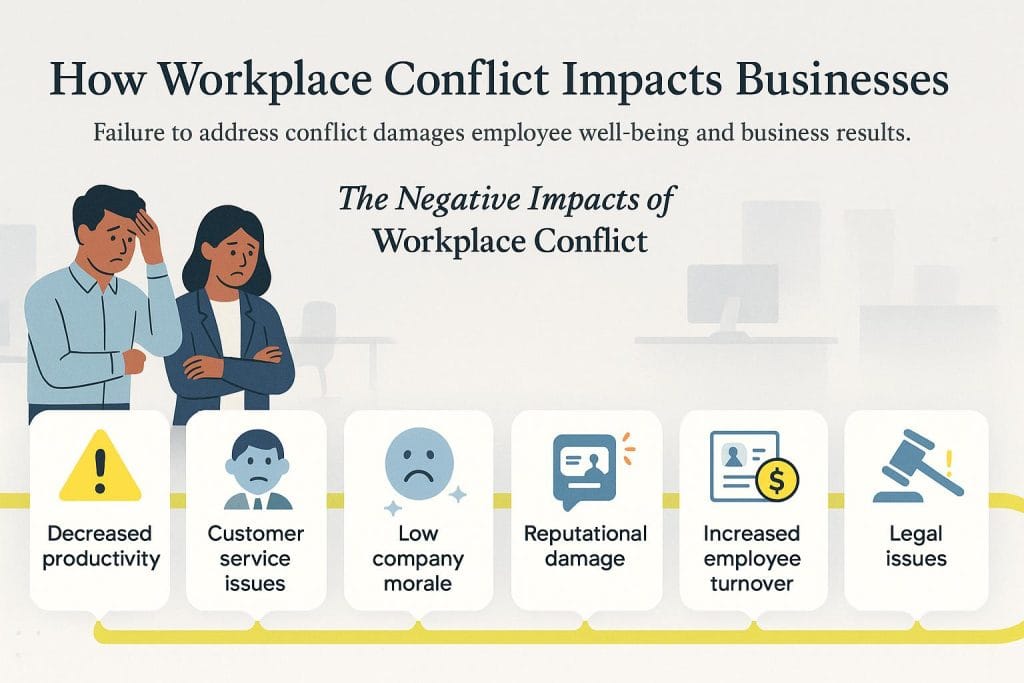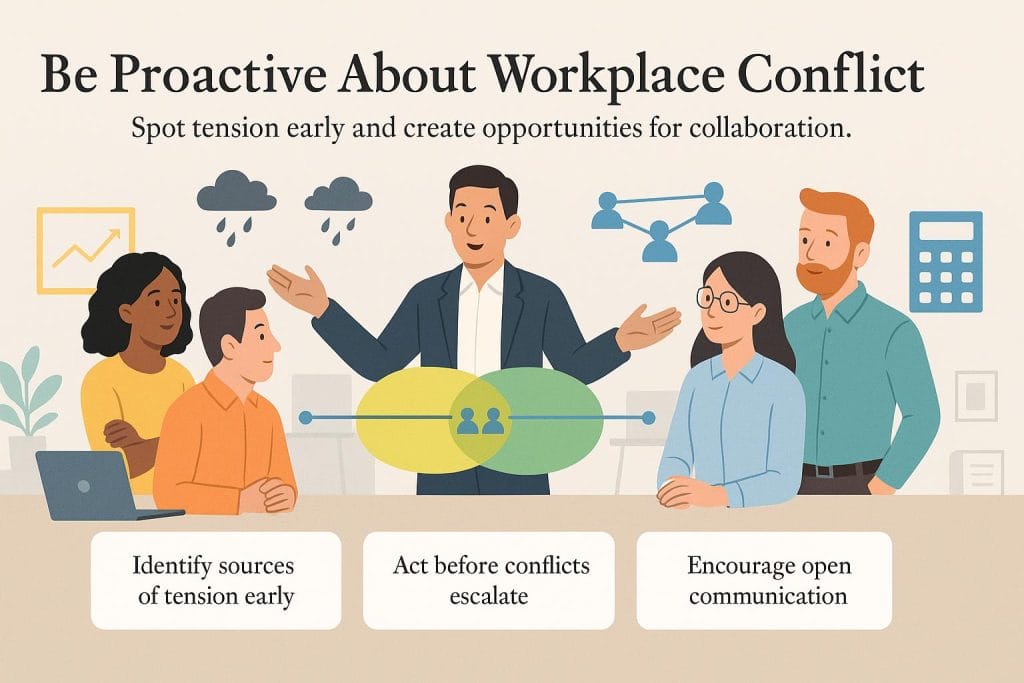Business.com aims to help business owners make informed decisions to support and grow their companies. We research and recommend products and services suitable for various business types, investing thousands of hours each year in this process.
As a business, we need to generate revenue to sustain our content. We have financial relationships with some companies we cover, earning commissions when readers purchase from our partners or share information about their needs. These relationships do not dictate our advice and recommendations. Our editorial team independently evaluates and recommends products and services based on their research and expertise. Learn more about our process and partners here.
Workplace Conflict: Tips for Managing Conflict in the Workplace
Workplace conflict results in reduced productivity, increased employee absenteeism and eventually higher turnover. Follow these tips to deal with conflict at work more effectively.

Table of Contents
Conflict is an unavoidable part of every work environment, whether your employees work in an office, remotely or a hybrid schedule. According to the Workplace Peace Institute’s 2024 “State of Conflict in the Workplace” survey, U.S. workers spend an average of two hours per week dealing with conflict. This stressor costs companies $3,216.63 per employee per year in lost productivity, among other consequences.
Although disputes are never fun, business leaders and their team members shouldn’t avoid handling workplace conflict. Ignoring conflict at work allows it to escalate and negatively impact the organization further, while addressing and resolving the problem quickly helps maintain a positive work environment. Here are some tips on how to resolve conflict in the workplace effectively within your company.
What is workplace conflict?
Workplace conflict or organizational conflict occurs when two or more people who work together have a disagreement due to differing interests or ideas. Common reasons for conflict in the workplace include:
- Unclear expectations
- Lack of teamwork
- Poor communication
- Stress or burnout
- Rude behavior
- Bullying or harassment
- Lack of transparency or honesty
- Inadequate performance
- Poor leadership
- Opposing values or personality types
Understanding conflict through established frameworks
Before diving into management strategies, it’s helpful to understand conflict through proven academic frameworks. The Thomas-Kilmann Conflict Mode Instrument (TKI), developed by Kenneth W. Thomas and Ralph H. Kilmann in 1974, provides a research-based approach to understanding how individuals handle conflict situations.
The TKI framework identifies five conflict-handling modes based on two underlying dimensions: assertiveness (the extent to which someone tries to satisfy their own concerns) and cooperativeness (the extent to which they try to satisfy the other person’s concerns).
The five conflict modes are:
- Competing (high assertiveness, low cooperativeness): This approach prioritizes achieving one’s own objectives above all else, often requiring the use of authority, position or persuasive skills to advance personal goals. It’s characterized by a win-lose mentality where success is measured by getting your way.
- Collaborating (high assertiveness, high cooperativeness): This strategy involves all parties working together to find creative solutions that fully address everyone’s underlying concerns and interests. It requires open communication, active listening and time investment to develop innovative approaches that create mutual value.
- Compromising (moderate assertiveness and cooperativeness): This method focuses on finding mutually acceptable solutions where each party gives up something to gain something else. It typically involves splitting differences or making concessions to reach a workable agreement that partially satisfies all involved.
- Avoiding (low assertiveness, low cooperativeness): This approach involves stepping away from conflict situations rather than engaging directly with the issues or people involved. It may include postponing difficult conversations, sidestepping controversial topics or withdrawing from tense situations entirely.
- Accommodating (low assertiveness, high cooperativeness): This style emphasizes preserving relationships and ensuring others’ satisfaction, often at the expense of one’s own immediate interests. It involves giving in to others’ preferences and focusing on harmony over personal outcomes.
Understanding these modes helps leaders and employees choose the most appropriate approach for specific conflict situations.
Another valuable resource is the Harvard Negotiation Project, founded in 1979 at Harvard Law School, and its successor, the Harvard Program on Negotiation (PON). The program has developed extensive research on conflict resolution and negotiation theory that applies directly to workplace settings. For example, PON recommends following Harvard Law School professors Frank E. A. Sander and Robert C. Bordone’s dispute system design principles for “diagnosing, designing, implementing and evaluating an effective method for business conflict management.”
Tips for managing conflict in the workplace

According to SHRM’s 2023-24 “State of the Workplace Report,” only 58 percent of HR professionals surveyed said their organizations effectively ensured a civil and respectful workplace culture. The following tips can help employees and business leaders effectively deal with conflict in their workplaces and maintain an inclusive, welcoming culture.
1. Be proactive.
One of the best ways to resolve workplace conflicts is to prevent them from occurring in the first place. Attempt to proactively identify potential conflict areas and intervene before any dispute occurs. Understand the natural tensions in your workplace and learn how they can best be minimized or eliminated. If a conflict does arise, being proactive will most likely lessen its severity and length.
For example, if you know your marketing department doesn’t interact well with the accounting department, that could potentially lead to conflict. A good leader will recognize this and take steps to build a positive relationship between the departments. This can set up a collaborative environment instead of an adversarial climate. Being proactive with conflict is always time and effort well spent.
2. Set clear expectations for acceptable behavior.
Don’t assume employees will understand what constitutes acceptable workplace behavior and what doesn’t. This can cause confusion and misunderstanding down the line. Instead, establish clear policies for what is and isn’t acceptable behavior in the workplace with all new hires and regularly remind existing employees of the behavioral standards you expect.
Since many employees may work in a remote or hybrid setting rather than a traditional office, defining the “workplace” can be tricky. To avoid confusion, create a remote-work plan that establishes expectations for remote workplace behavior and ensures it’s enforced regularly. Similarly, develop a plan for in-office employees. Once you establish clear expectations for workplace behavior in all company settings, include them in your employee handbook and review them with your workforce. Have each worker sign an annual acknowledgment of acceptance and understanding.
The last piece of setting expectations is ensuring your standards are constantly reinforced across the organization. Be fair in how you react to each situation as conflicts arise. For example, if you have a zero-tolerance policy for bullying, no employee should ever be allowed to bully others ─ no exceptions.
3. Promote healthy communication.
Communication is key in all aspects of business, and conflict management is no exception. A lack of clear communication can cause a multitude of problems. For example, if communication is unclear, an employee might not understand what type of behavior is expected or misinterpret another’s intentions as malicious. Train your employees and managers on how to best communicate with each other when they’re at work.
As many employees work from home, it’s important to note that poor communication may play a larger role in workplace conflict among remote workers. There have been many advancements in digital communication in recent years, but virtual communication can still be strained or awkward. It’s easier to misinterpret people over digital platforms like email and instant messaging because you lose out on tone, inflection and nonverbal cues. Online communication can also cause problems when workers fail to respond to messages, intentionally or not. Setting and enforcing an etiquette policy for digital communication can help.
4. Choose your timing wisely.
Timing is everything. While it’s essential not to let a workplace conflict linger, you also don’t want to try to resolve a dispute when tempers are still elevated. Sometimes, it’s better to speak with people individually while you let things cool down among the affected employees. People who are upset don’t always make rational decisions or have the emotional distance to see the conflict clearly.
By engaging employees in a mediation session before they’re ready, you might unintentionally escalate the conflict. The goal is to resolve the issue, and to achieve this successfully, all parties need to be on the same page and ready to address the core issues calmly. If this can’t happen, consider whether there is a better time or way to attempt to resolve the conflict. Learn about when to seek professional help resolving conflicts below.
5. Train your leaders.
Although workplace conflict is a major business issue that company leaders must address effectively, they often lack the experience and skills necessary to facilitate conflict resolution. Many even suffer from apprehension and/or avoidance when conflicts arise.
Train your leadership team, especially those leaders working remotely, on how to manage employees effectively, particularly as it relates to conflict. Instead of assuming they know what to do, offer your managers formal education on properly handling disagreements and opposition in the workplace. You might also consider training on related topics like workplace discrimination and harassment, even if they’re not required legally. Equipping your supervisors with tools to de-escalate and resolve situations can make a big difference in how successful their efforts are and how much conflict affects your business.
>> Learn about anti-discrimination laws in the workplace.
6. Remember the WIIFM factor.
WIIFM stands for “what’s in it for me?” and it’s really what employees tend to care about the most. They want to know how things affect them personally and what they have to lose or gain in a given situation. This is also a key factor in their motivation and can influence how they respond to conflict.
Understanding WIIFM becomes particularly crucial during conflict situations because people’s self-interest concerns are often heightened when they feel threatened or uncertain. In workplace conflicts, team members typically aren’t just disagreeing about facts or processes — they’re protecting something they value, whether it’s their reputation, workload, autonomy or career prospects. Effective conflict management requires identifying and addressing these underlying personal stakes rather than just focusing on the surface-level disagreement.
When people feel their core interests are acknowledged and protected, they’re more likely to engage constructively in finding solutions. Conversely, when someone perceives that a proposed resolution threatens what matters most to them personally, they may become defensive, resistant or even sabotage agreements they’ve publicly accepted. Smart conflict resolution involves helping each party articulate their WIIFM concerns and then crafting solutions that either protect those interests or provide acceptable trade-offs everyone can genuinely support.
7. Use conflict as a learning opportunity.
Look at every workplace conflict as an opportunity for learning and growth. Sometimes, when handled correctly, disagreement and conflict can even be healthy. You should leverage conflict to help with team-building and learning at the organizational or individual level.
Ask yourself and your team, “Which larger lessons can we learn from this conflict? How can we use those lessons to prevent future workplace conflicts?” By asking the right questions, you can spur internal innovation and improve the workplace. Smart leaders are always looking for ways to ensure that every situation, even a conflict, has a positive outcome and effect on the company.
Types of workplace conflict
Workplace conflict can arise from a variety of sources, but some of the most common types can be grouped into three main categories:
- Task-based conflict: This type of conflict arises from disagreements about the content or execution of work. This could include things like deadlines, resource allocation, project management styles or differing opinions on how to approach a task.
- Relationship-based conflict: This stems from interpersonal clashes between colleagues. It might be caused by personality differences, communication problems or simply a dislike for someone.
- Value-based conflict: This arises from fundamental differences in beliefs or ethics. This could be related to work styles, priorities or even personal values, such as political, religious and social beliefs, that spill over into the professional sphere.
In addition to these three main categories, other types of workplace conflict can include:
- Leadership-based conflict: This arises when there are disputes about leadership styles, decisions or management approaches. It can occur between leaders and subordinates or among members of the leadership team.
- Work style-based conflict: This occurs when there are differences in how people prefer to work, such as needing quiet versus having background noise, being a morning person versus a night owl, or preferring individual work versus collaboration.
- Discrimination-based conflict: This type of conflict arises when employees are treated unequally based on race, gender, age, religion or other protected characteristics. It’s a serious issue requiring immediate human resources (HR) intervention.
Understanding the different types of conflict can help you identify the root cause of a disagreement and develop a more effective strategy for resolving it.
When to seek professional help resolving conflicts
While many workplace conflicts can be resolved through internal processes, certain situations require professional intervention. Recognizing when to escalate disputes to HR leaders or external professionals is crucial for maintaining a safe, productive workplace and protecting your organization from legal liability.
Signs you need HR intervention
Escalate to HR when conflicts involve:
- Policy violations outlined in your employee handbook.
- Performance issues that affect multiple team members.
- Complaints about management practices or company culture.
- Situations requiring formal documentation for potential disciplinary action.
- Conflicts that create hostile work environments.
Signs you need professional mediation
Consider professional mediation services when:
- Conflicts involve allegations of discrimination, harassment or other legal violations.
- Multiple attempts at internal resolution have failed.
- The conflict involves senior leadership or creates power imbalances that internal processes cannot address.
- Personal relationships have deteriorated to the point where productive communication is impossible.
- The conflict affects team performance and business operations significantly.
Signs you need legal consultation
Seek legal consultation immediately when conflicts involve:
- Sexual harassment or discrimination based on protected characteristics.
- Workplace violence or threats of violence.
- Retaliation against employees who have filed complaints.
- Violations of federal or state employment laws.
- Situations that could expose the organization to significant liability.
The U.S. Department of Labor (DOL) provides guidance on both workplace violence prevention and alternative dispute resolution (ADR), emphasizing the importance of early intervention and formal processes for addressing workplace conflicts before they escalate. The DOL’s workplace violence program highlights early intervention techniques as vital for preventing escalation to threatening situations, while their ADR guidance promotes formal processes like mediation, arbitration and neutral factfinding to resolve disputes and improve communication between parties before conflicts reach litigation.
The impact of workplace conflict

Workplace conflict can cause workers to feel stressed, anxious, depressed and unconfident. As a result, it can also impact your business negatively in these ways:
- Decreased productivity: Conflict can distract or cause employees to lose motivation, reducing their performance and productivity.
- Customer service issues: Team members who are stressed and distracted by conflict are less likely to provide excellent customer service. This can lead to unhappy customers and lost business.
- Low company morale: When left unmanaged, workplace conflict is bad for company culture and morale. Employees affected by work disputes may start showing up late to work or even not at all, placing the burden on co-workers who must cover for them.
- Reputational damage: Unhappy employees might badmouth the company to colleagues, friends or even on social media. This can damage the business’s reputation and make it harder to attract top talent.
- Increased employee turnover: If workplace conflict is bad enough, it can ultimately result in higher turnover rates as employees choose to quit the company or need to be let go.
- Legal issues: In severe cases, unresolved conflict can escalate to harassment, discrimination or even lawsuits. These can be costly for businesses financially and in terms of reputation.
Addressing workplace conflict promptly and effectively minimizes these negative impacts and maintains a healthy, productive work environment. By implementing proven conflict management strategies, training leaders in evidence-based techniques and knowing when to seek professional help, organizations can transform workplace conflicts from costly disruptions into opportunities for growth and innovation.
Zak Mustapha contributed to this article.










